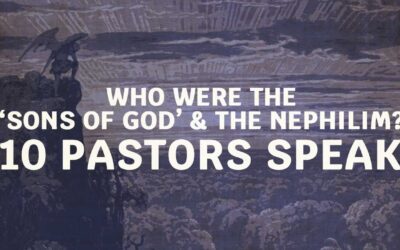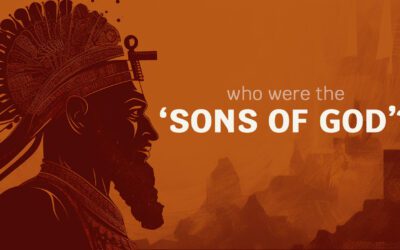
Explore Dr. Douglas Petrovich’s 13 arguments on why the ‘sons of God’ or the Nephilim are angels and not descendants of Seth.
Introduction
Dr. Douglas Petrovich is a biblical scholar and academic contributor. Since the 1980s, he taught over 30 different courses, and founded Novosibirsk Biblical-Theological Seminary in Akademgorodok, Russia. There, he worked as the Academic Dean and Assistant to the President for 10 years.
In his article titled “Identifying the ‘Sons of God’ in Genesis 6:1-7“ Dr. Petrovich presents 13 reasons why the text of the passage supports the interpretation that the ‘sons of God’ are not Sethites, but angels.
Read the full paper if you get a chance, and we have summarized his points below.
Why “Sons of God” are Angelic Beings, Not from Seth
Dr. Petrovich’s analysis hinges on a series of cogent arguments that draw from both scriptural interpretation and linguistic analysis. Here, we distill his perspective through key points:
1. Distinct Contrast and Separate Entity:
Right from the beginning, the author makes a strong distinction between the “sons of God” and the “daughters of mankind.” This suggests that the “sons of God” are a completely different group of beings.
Now, if we look at Genesis 4:25, we see that Seth is directly linked to Adam, who is referred to as “the man.” Both Cain and Seth, despite their differences, trace their lineage back to Eve, who is considered the mother of all humans.
So, in a way, both of them could be called “sons of the man” because they come from Adam. However, nowhere in the Bible is their offspring referred to as “sons of God.”
2. Absence of Cainite and Sethite Lines
In Genesis 6, we won’t find any mention of Cain or his descendants nor Seth or his descendants.
For this reason, anyone trying to read either Cain’s or Seth’s line into the text of Genesis 6 is essentially on very uncertain interpretive ground. Why would an interpreter bring up a person or their lineage in the narrative if the original biblical author didn’t include it?
If it’s not in the text, it shouldn’t be assumed to be there, and trying to insert it could lead to misinterpretation.
2. Common Reference of “The Man”
Dr. Petrovich points out that the beginning of Genesis 6 presents two key statements concerning “the man” created by God.
The first statement suggests that mankind as a whole began to increase on the earth, indicating their collective growth. The second statement notes the birth of daughters within the line of mankind.
Dr. Petrovich emphasizes that this doesn’t imply the absence of sons among men. Instead, the author seems to use the mention of daughters being born to mankind as a preamble for the discussion that follows in the subsequent verses.
The close connection between Genesis 6:1 and Genesis 6:2 onward, suggests that “the man” should be understood as the same in both verses.
Furthermore, if proponents of the Cain-Seth view argue that Genesis 6:1 speaks of Cain’s line increasing, it raises questions about what happened to Seth’s line. Did it become extinct?
Because of this, the Sethite interpretation seems inconsistent. Especially if one proposes that Seth’s line is the focus in 6:2 and that Sethites are numerous enough to populate the earth through relationships with female descendants of Cain.
In such a case, both lines should logically be described as increasing.
Additionally, Dr. Petrovich highlights a grammatical issue in Genesis 6:1. If Cain is considered “the man” in the phrase “daughters of the man” in Genesis 6:1, it would imply that Genesis 6:1 speaks exclusively of Cain (“…that Cain began to multiply…”).
However, Genesis 6:1 ends with a plural pronoun, “them,” whose antecedent is “the man.” This grammatical mismatch between the singular noun “man” and the plural pronoun “them” challenges the idea that “daughters of the man/mankind” in Genesis 6:1 refers to the female line of Cain in Genesis 6:2.
4. Targeted Divine Anger
“When the sons of God went into the daughters of men (Gen 6:2), God became angry. Yet
God did not become angry with the sons of God, but only with “the man.””
Dr. Petrovich goes on to discuss how when the “sons of God” intermarried with the “daughters of men” (Genesis 6:2), it resulted in God’s anger. Notably, God’s anger wasn’t directed towards the “sons of God” but specifically towards “the man” (Genesis 6:3). This is a key point for proponents of the Cain-Seth view who identify “the man” as representing Cain’s ungodly line.
The Sethite interpretation becomes more questionable if we consider God’s subsequent judgment in Genesis 6:3, which limits “his” days to 120 years.
If this limitation strictly applies to Cain’s line, it implies that Seth’s future descendants would NOT be subject to this 120-year lifespan restriction. However, when we look at the fulfillment of this promise, even the Sethite lineage was wiped out.
5. Equating “Sons of the Man” to Mankind
In Genesis 11:5, it says that God comes to inspect the tower and city built by the “sons of the man.” This construction bears similarity to the language used in Genesis 6:1, with the key difference being that in Genesis 11:5, these “sons” are attributed to mankind as a whole, not to God.
This reference is a straightforward allusion to humanity and doesn’t specify the line of Cain, or for that matter, any other individual’s line, through implied inference.
Proponents of the Cain-Seth view need to reconcile the fact that in Genesis 11, Adam’s descendants are simply referred to as the “sons of mankind,” while in Genesis 6, their supposed “godly line” is labeled as the “sons of God.”
6. Ordinary Marriages, Abnormality Emphasis
If the Nephilim were offsprings of descendants of Cain and Seth, who were all humans, then they should’ve not been considered abnormal in any way. The fact that this was emphasized in the verses, supports the idea that they were in fact born from angels.
Not to mention, the Sethite interpretation labels every descendant of Cain as evil and godless, while painting every descendant of Seth as righteous. This assumption lacks solid scriptural evidence and
7. Linguistic Implications
Dr. Petrovich emphasizes that in Genesis 6:4, “sons of God” are synonymous with beings existing from eternity. Angels fit this description, whereas humans like Seth’s lineage do not.
Furthermore, the term “sons of God” is consistently angelic in the Hebrew Bible, never referring to humans. For example, in Daniel 3:25 and Job (Job 1:6; 2:1; 38:7) the term “son of God” refers to an angel’s distinct appearance.
8. Thwarting Interference with Jesus’s Lineage
Aligning with Christ’s proclamation to spirits disobedient in Noah’s time, Dr. Petrovich argues that evil angels attempted to interfere with Jesus’s lineage, thwarted by Christ’s proclamation.
A Continuation of Exploration
Dr. Petrovich’s analysis stands as a valuable contribution to the debate on whether the Nephilim are born from angels or Sethites. Regardless, in this digital age, misinformation and sensationalized content abound, complicating the pursuit of truth.
Chasing the Giants’ mission is to provide a platform that separates fact from fiction, offering quality research on the topic of Nephilim in Genesis. By doing so, we hope to aid seekers in finding answers while pointing to the Bible’s timeless wisdom and truth found in Jesus.
Read Dr. Petrovich’s full article entitled “Identifying the “Sons of God” in Genesis 6:1–7” to learn more.





